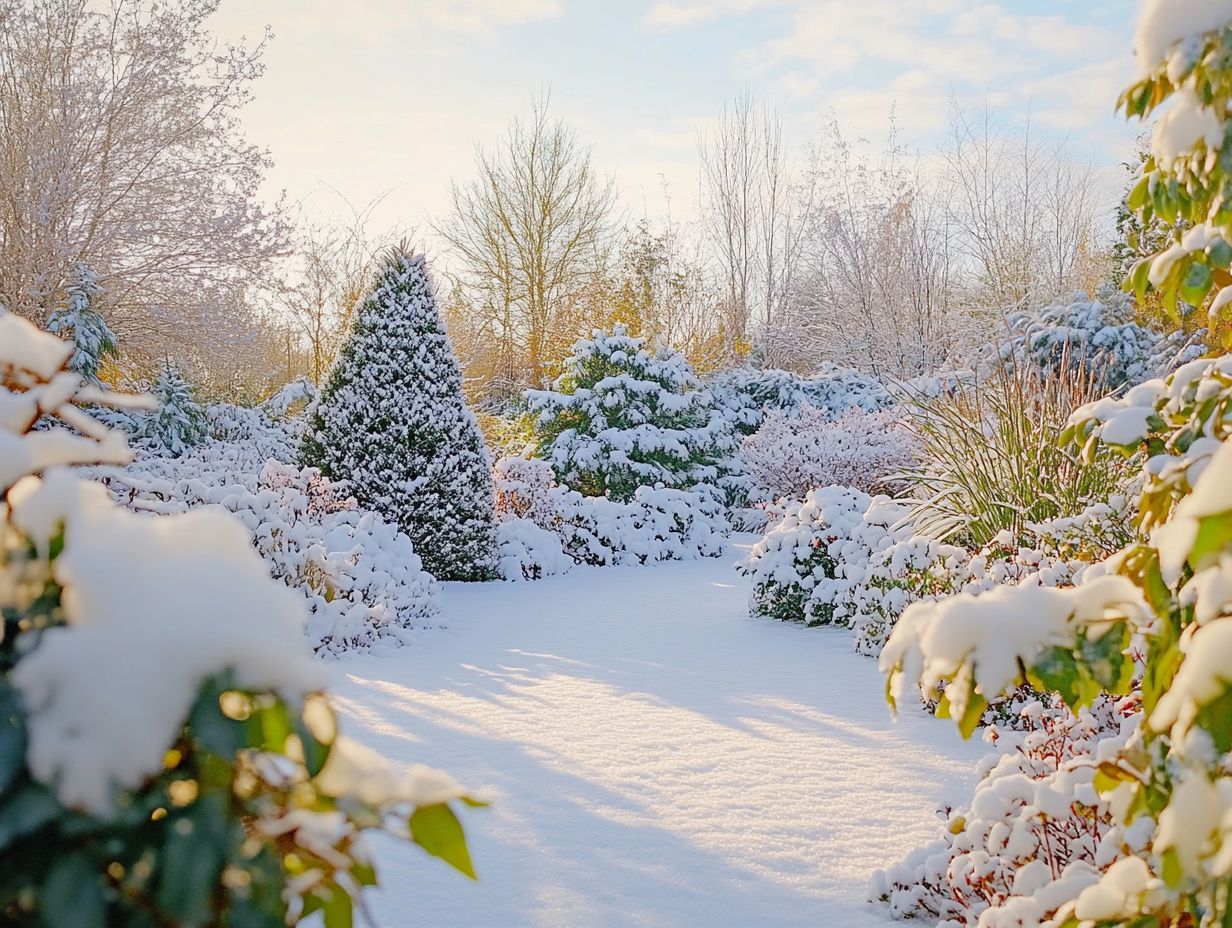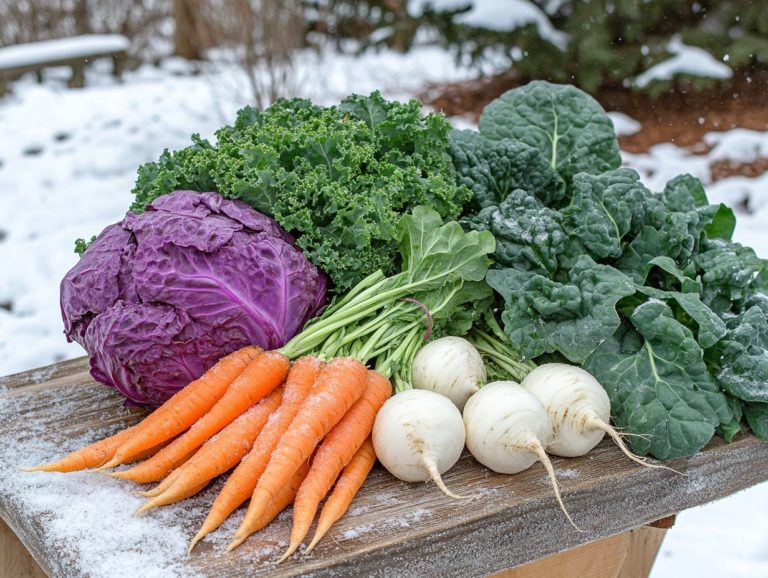Choosing the Right Plants for Cold Climates
Cold climates pose distinct challenges for gardeners, but with the right knowledge and careful plant selection, you can cultivate a flourishing landscape, even in the iciest conditions!
This article delves into the factors that affect plant growth in these environments. It emphasizes the advantages of choosing resilient varieties.
It outlines the types of suitable plants, including herbaceous perennials and flowering bulbs, essential considerations for selection, effective winter maintenance tips, and common pitfalls to steer clear of.
Arm yourself with practical insights to transform your cold-weather gardening into a resounding success!
Contents
Key Takeaways:

- Plants suitable for cold climates must be adaptable and resilient to survive harsh conditions.
- Consider hardiness zones and sun/shade requirements when choosing plants for cold climates.
- To maintain plants in cold climates, protect them from frost and winterize them properly.
Understanding Cold Climates
Understanding cold climates is essential for successful gardening. It requires recognizing the various factors that influence plant growth in these chilly regions, including selecting plants for cold climate community gardens.
Cold climates often endure harsh winters, with temperatures plunging significantly, presenting serious challenges for gardeners.
To flourish, plants must show amazing traits, such as ability to survive cold weather and resilience, which are typically categorized by the USDA hardiness zones. These zones categorize plants based on their ability to withstand different temperature ranges.
By gaining a thorough understanding of these climatic conditions, you can select plants for shade in cold climates that will withstand the cold and take advantage of seasonal moisture. This transforms cold climate gardening into both a feasible and rewarding endeavor.
Factors that Affect Plant Growth in Cold Climates
Several factors significantly influence plant growth in cold climates, including temperature fluctuations, soil composition, and seasonal moisture.
These elements dictate which types of hardy species can truly thrive.
In these regions, you ll likely face unique challenges like frost heaves, frozen soil, and limited sunlight. All of these can severely stunt the growth of even the hardiest species.
To counteract these issues, adopting winter protection strategies, such as using shelterbelts, is essential. Mulching with organic materials not only insulates the soil but also maintains moisture levels.
Using row covers can protect delicate plants from biting winds and sudden temperature drops. A careful selection of cold-hardy varieties, including perennial cornflower and other hardy plants, can enhance the resilience of your garden during the harsh winter months.
This ensures that life persists even in the coldest climates.
Benefits of Choosing Plants for Cold Climates
Opting for plants that thrive in cold climates, like cold-hardy perennials such as Delphinium and Peony, presents a wealth of advantages, especially when you consider sustainable plant choices for cold climates!
By selecting the right plant species, including Lavender and Sage, you not only elevate the aesthetic appeal of your garden but also enhance the resilience and adaptability of your plants to the distinct challenges posed by cold weather.
Connecting with local growers can offer invaluable insights into the ideal plant selections tailored to your specific area’s conditions. This ultimately guides you toward a more successful and rewarding gardening experience.
Adaptability and Resilience
Adaptability and resilience are essential traits for any plants you’re nurturing in cold climates. These traits enable them to withstand the challenges of winter and emerge even stronger come spring!
These qualities shine through in a variety of hardy species, including Magnolia and Camellia, which have developed unique survival strategies for harsh conditions.
Native evergreens like Juniper and Boxwood have needle-like leaves that minimize moisture loss, allowing them to photosynthesize even when cold temperatures plummet.
Perennials like sedum and lavender demonstrate remarkable durability by entering a dormant phase during winter to conserve energy.
Employing winter protection measures such as mulching or using protective coverings can further enhance these plants innate strengths. This ensures they not only survive the chill but also thrive as soon as warmer weather makes its grand return!
Don’t wait! Choose plants that can thrive in winter! Get started today and transform your garden into a winter wonderland!
Types of Plants Suitable for Cold Climates

You can cultivate a diverse array of plants that thrive beautifully in cold climates, such as resilient cold-hardy perennials, delightful herbaceous perennials, and an assortment of colorful flowering bulbs. To ensure their success, consider choosing the right soil for cold-climate gardening.
You have a variety of choices for cold climate gardening. This makes it a vibrant and rewarding experience.
Perennials, Annuals, and Biennials
In cold climates, grasping the differences between perennials, annuals, and biennials is vital for your gardening success, particularly when choosing cold-hardy varieties from local growers.
Perennials, such as the resilient daylily and the hardy coneflower, return year after year, making them both economical and low-maintenance options for your garden.
Annuals, like pansies and calendulas, burst with vibrant color for a single season, but their lifecycle means you’ll need to replant them each year.
Biennials, including foxglove and hollyhock, take two years to bloom, offering unique blossoms that can truly elevate your garden s aesthetics.
By opting for cold-hardy varieties like Pyrethrum, you ll ensure that your plants can thrive even through the harshest winters. Sourcing from local growers supports your community while enhancing your chances of picking varieties that are well-suited to your regional climate.
This thoughtful approach will lead to a more rewarding and successful gardening experience.
Factors to Consider When Choosing Plants
When selecting plants for cold climate gardening, you must pay attention to several essential factors, including hardiness ratings. Understanding how to choose the right plants for cold weather will help you see how well plants can survive cold temperatures. Consider hardiness zones and sun or shade requirements to guarantee successful growth and sustainability.
Choose wisely to set the stage for a thriving garden!
Hardiness Zones and Sun/Shade Requirements
Understanding hardiness zones is essential for your plant selection, as these zones dictate which species can truly thrive in specific temperature conditions, along with their sun and shade preferences.
These zones span from the warm embrace of Zone 10, where tropical delights like hibiscus and bougainvillea flourish, to the frigid realm of Zone 2, which accommodates tough species like Montana and certain evergreens. Each zone presents a distinct environment, making it crucial for you to consider not just the climate but also the sunlight conditions specific to your garden.
For instance, tomatoes love full sun, needing at least six hours daily, while ferns thrive in cooler, shaded spots, making them suitable for raised beds.
This illustrates the importance of grasping plant preferences. By aligning hardiness zones with the right light exposure, you can cultivate healthier, more vibrant gardens, ultimately nurturing a thriving ecosystem.
Tips for Maintaining Plants in Cold Climates
Maintaining plants in cold climates demands a thoughtful approach, utilizing specific strategies that include winter protection measures and meticulous maintenance techniques. By implementing these methods, you can ensure your plants not only survive but thrive in harsh conditions.
Protecting from Frost and Winterizing

Frost protection and winterizing techniques are essential for safeguarding your plants against extreme cold, ensuring that your hardy specimens can withstand the winter season.
By implementing effective frost protection methods like mulching and draping breathable fabrics, you can protect your plants when temperatures drop. Covering delicate plants with frost cloths or burlap adds an extra layer of defense against harsh winds and frostbite.
Winterizing your plants is vital to keep them safe and thriving during the harsh months! These practices help keep root systems intact while supporting overall plant health.
With regular maintenance and proactive measures, your gardening efforts can transform into a thriving landscape come spring.
Common Mistakes to Avoid
Avoiding common pitfalls in cold climate gardening is crucial for your success. Mistakes like selecting invasive species or neglecting to consider microclimates can significantly impede plant growth and long-term sustainability.
By being mindful of these factors, you can create a thriving garden that flourishes even in challenging conditions.
Choosing Invasive Species and Overlooking Microclimates
Invasive species can profoundly impact local ecosystems. Neglecting microclimates may lead to disappointing results in your cold climate gardening efforts.
When invasive species take root, they often outcompete native plants, disrupting habitats and altering soil chemistry, which poses a threat to biodiversity.
Understanding microclimates unique climatic conditions in localized areas can enhance your success with various plant selections.
For example, identifying warm spots like south-facing slopes allows you to choose native plants that thrive in those conditions and support local wildlife.
Tap into local knowledge to find the best plants that match your soil type, moisture levels, and other environmental factors, ensuring your garden remains both sustainable and vibrant.
Frequently Asked Questions
Wondering about the best factors when choosing plants for cold climates?
When selecting plants for cold climates, consider their hardiness zone, cold tolerance, and their ability to endure harsh winter conditions like snow and ice. Additionally, choosing the right soil for cold-climate plants is crucial for ensuring their health and growth.
How can I find my hardiness zone?

Your hardiness zone is based on the average minimum winter temperature in your area. Use a hardiness zone map to find your zone, which divides the country into different temperature ranges.
What types of plants thrive in cold climates?
Plants that are either native to cold climates or bred for cold resistance typically excel in these environments. For more detailed insights, refer to our guide on understanding plant selection for cold-climate design. Examples include conifers, hardy perennials, and cold-weather vegetables like kale and cabbage.
Can I still have a colorful garden in a cold climate?
Absolutely! Many vibrant plants thrive in cold climates. Popular options include winter-blooming flowers like hellebores and winterberry, alongside colorful foliage plants like red-twig dogwood and dwarf conifers.
How can I protect my plants during winter?
To safeguard your plants in winter, apply mulch around their bases to insulate the roots against freezing temperatures. Cover delicate plants with burlap or other protective materials to shield them from harsh winds and snow.
Which plants can survive extremely cold temperatures?
Several plants can endure extremely cold climates, even sub-zero temperatures. These include evergreens like spruce and juniper as well as cold-hardy shrubs like arctic willow and Siberian dogwood. For those interested in gardening, selecting the right containers for cold-climate plants is also crucial for their success.






